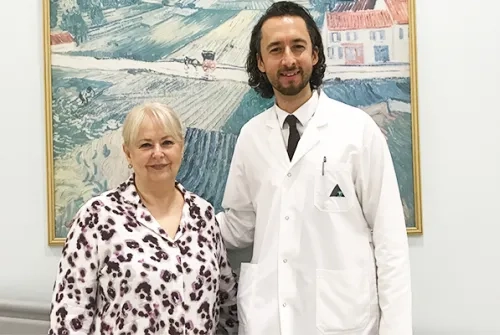Alo Yeditepe
Alo Yeditepe
Patients Who Undergo Joint Replacement Surgery Can Stand Up and Walk the Next Day
Retired primary school teacher Canan Pamukçu (71) had been suffering from advanced cartilage wear in both of her knees for 4 years. Due to fear, Pamukçu did not have surgery and tried to continue her daily activities by undergoing different procedures to relieve her pain. When she became unable to walk completely due to the pain, she applied to Orthopedics and Traumatology specialist Prof. Dr. Gökhan Meriç. Prof. Dr. Meriç, who applied knee prostheses to both of Pamukçu's knees at the same time, said "Patients who undergo joint replacement surgery, like Mrs. Canan, can stand up and walk the next day."
Canan Pamukçu, who had been constantly postponing treatment due to her fear of surgery and eventually had difficulty even walking alone, was able to return to her old life with the application of prosthetic surgery to both knees at the same time by Orthopedics and Traumatology specialist Prof. Dr. Gökhan Meriç. Saying "I was very sad for the three years after the surgery," Canan Pamukçu added, "It was not worth suffering so much pain and going through difficult days. I have no bad memories about the surgery. I had a chat with the medical team during the surgery with epidural anesthesia. Even though both knees were operated on, I stood up the next day."
Delaying Prosthetic Surgery Due to Fear Cost Years
Canan Pamukçu also talked about her process since 2019, saying, "My knee pains started in 2019; I started experiencing sudden, inflammatory pains while resting and sleeping at night. I had become afraid to go out alone. In addition to these, I also had a fear of undergoing surgery. I talked to many doctors and gained a lot of knowledge, but I could not make a decision. Finally, with the help of my son, I reached Gökhan Bey and decided to undergo surgery. Although both of my knees were operated on at the same time, I stood up the next day. After we returned home, I even left my crutches on the 14th day. I am happy; there is no need to live with pain. I see those three years as wasted years. I had two minor hernias in my waist, but those hernias turned into protruding hernias due to my unstable walking. Now I am also struggling with it, I wish I hadn't delayed it this much."
"Can Meet Her Daily Needs Very Easily"
Prof. Dr. Gökhan Meriç, who stated that Pamukçu returned to her normal life shortly after the surgery, said that her health is currently very good. "72-year-old Canan came to us with serious pain. Although she underwent small treatments for 3 years, she could not benefit from them, and her pain continued. We applied prostheses to both knees. We got her up and showed her exercises the day after the surgery. We did not have any problems such as swelling, wound pus, or discharge after the surgery. She also continued with physical therapy and was able to leave her crutches two weeks later. Although she currently has minimal pain, she can meet her daily needs very easily,”
"If You Wake Up at Night Due to Pain, It May Be Due to Cartilage Wear!"
Speaking about knee cartilage wear, Prof. Dr. Gökhan Meriç stated: "Knee cartilage wear is one of the biggest problems we see in women as they age. While cartilage wear can be caused by impact or falls, there is also a genetic predisposition in some patients. Our cartilage is a covering tissue, and joints have a smooth surface, which allows us to perform our daily movements without pain. However, with the wearing and tearing of these cartilages over time, advanced cartilage wear, also known as osteoarthritis, may occur. We recommend many treatment methods, such as knee injections, weight loss, and exercise, to protect against early cartilage wear. However, if the symptoms persist in patients over the age of 60-65, and they continue to experience difficulties in their daily movements, cannot walk 500-600 meters without pain, and experience pain that wakes them up at night, we apply knee prosthesis.
"There are Misconceptions / Incomplete Information About Knee Replacement Surgery!
Prof. Dr. Meriç, emphasizing that knee replacement surgery involves removing the coating tissue on the surface of the joint cartilage and placing a metal coating there, provided the following information: “There is a misconception among the public that the knee bone is completely cut, or the entire knee is removed. Our goal is to make the worn knee surface smooth again. For this, we only remove the cartilage area and place a metal implant there. We make an incision into the bone to create a smooth surface again in the joint, but we only remove the cartilage area and place a metal implant there. We put a plastic polyethylene material between the two metal surfaces. With this, we ensure that the patient can lead a comfortable daily life. We increase the success of our knee replacement surgery by performing the surgery with appropriate surgical techniques, taking precautions against possible risks, and selecting the most suitable implant for the patient's knee structure. Our aim is to enable the patient to walk as soon as possible and to prevent them from being bedridden."
"Proper Patient Selection is Important"
Underlining that very successful results can be achieved from knee replacement surgeries when the principle of "applying the right prosthesis to the right patient" is fulfilled, Prof. Dr. Gökhan Meriç continued his words as follows:"Today, the postoperative process in knee replacement surgery can be said to be quite comfortable for the patient. The patient, who stays in the hospital for 4-5 days after the operation, is told about the exercises and walking techniques that should be done after the operation. Since the aim is to ensure that the patient walks comfortably in daily life, we put our patients on their feet the day after the operation. And we ensure that they move regularly. We can also prevent possible complications by minimizing the risks that may develop after surgery with various drug treatment."
"If The Patient Maintains Good Muscle Strength, The Prosthesis Can Be Used for Approximately 20-25 Years"
Pointing out that the lifespan of the prosthesis can vary between 15-25 years depending on the patient's weight and use, Prof. Dr. Gökhan Meriç, an Orthopedics and Traumatology specialist at Yeditepe University Hospitals, says, "When a heavy patient engages in intense activity, the wear and tear can be slightly higher compared to other people. That is why we try to keep the patient's muscle strength high. If the patient maintains good muscle strength and pays attention to their weight after the prosthesis surgery, they can use the prosthesis for approximately 20-25 years. Although prostheses are sometimes performed on young patients with serious problems, we generally prefer to apply them to patients aged 60-65 and over. If the patient has been late or afraid to undergo prosthesis surgery, they may have to endure constant pain in their daily life. Some patients wait 1-2 years, and this period not only affects the patient's psychology but also causes them to become disconnected from daily life. The patient starts to avoid going places they normally would, leading to inactivity and weight gain, which in turn exacerbates their pain, creating a vicious cycle for the patient."
Press Coverage: sabah | dha | sondakika | haberton | yeniakit | winally
This content was prepared by Yeditepe University Hospitals Medical Editorial Board.
”
See Also
- Robotic Hip Replacement Surgery
- Knuckle Cracking Can Be Dangerous When It Becomes a Habit!
- What is Hallux Rigidus (Stiff Big Toe/Toe Arthritis)? Symptoms and Treatment
- What is Hallux Valgus (Bunion)? How is it Treated?
- Meniscus and Cartilage Transplantation Can Be Done at the Same Time
- Ergonomics in Automobiles Prevents Accidents
- Joint Pain and Causes of Joint Pain
- Walking and Returning to Social Life After Knee Replacement Surgery
- Robotic Knee Prosthesis Surgery
- Big Toes Can Be A Big Problem!
- What is Synovitis in Joints?
- Hip Impingement Syndrome
- What is the Future of Treating Cartilage Problems?
- Not Only Athletes Suffer from Meniscus Tears!
- Is Cartilage Damage More Common in Those Who Run for Long Periods?
- Beware If Your Shoulder Or Neck Pain Lasts Longer Than Two Days After Swimming!
- Mistakes While Swimming Can Cause Shoulder Pain
- Myths About Fractures
- Vitamin D Deficiency May Be The Cause Of Your Joint Pain
- Have Your Baby Take Their First Steps in Good Health
- Heavy School Bags Can Cause Pain in the Lower Back, Shoulders, and Hands!
- Sports Injuries
- Cartilage Transplantation from Donor Has Been Started to Perform in Turkey
- Working From Home Increases Waist and Neck Problems
- First Cartilage Transplant from a Donor
- Pay Attention to the Pain That Occurs in the Front Part of Your Knees While Playing Sports!
- Young Patient Who Could Not Walk Due to Cartilage Damage Recovered With Cartilage Transplantation
- Knee Arthritis
- Knee Pain
- Crunching in the Kneecap May Be a Sign of Calcification
- Injured Athletes Can Return To Sports With Cartilage Transplant
Alo Yeditepe


